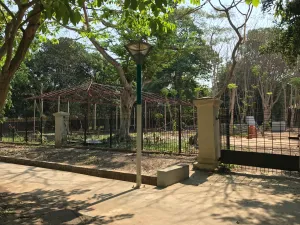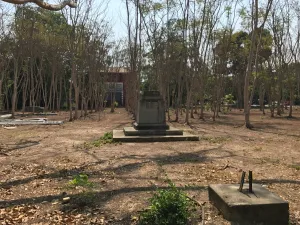Diana Huynh examines the historical and contemporary controversy of the Rangoon University Student Union.
The demonstrations that took place in Mawlamyine, Mon State, in late March regarding the naming of a new bridge have brought forth substantial tension that undergirds local ethnic politics in Myanmar. The dispute over the National League of Democracy (NLD) government’s decision to call the bridge Bogyoke Aung San instead of the local population’s wish to call it ‘Ramonya’ or ‘Thanlwin-Chaungzone’ not only reflected the nebulousness of the 2017 by-elections, but also suggested the latent challenges facing the future negotiations of a federal union.
The Mon State bridge incident is one of several ‘symbolic issues’ recently captured in the news; issues that ought to be analysed closely in order to grasp the political realities of Myanmar’s ongoing reforms and transition. What might come to mind when I talk about politics and the ‘symbolic’ is perhaps Daw Aung San Suu Kyi’s tepid responses on the human rights situation in Rakhine, which the international media was quick to criticize a couple of weeks ago. Yet, I would add that if there is another pressing subject that deeply captures the opportunities and challenges that the NLD government faces after a year in power, it is the controversy surrounding the reconstruction of the former Rangoon University Student Union (RUSU) building. The RUSU issue is deeply embedded within the landscape of higher education policies, the democratic rights of students, and the development of university campuses. The site today therefore offers an important node in which to understand why the NLD government cannot easily deliver sweeping change with immediate effect (as many had hoped), but also questions the potential for bringing broader social issues such as the ethnic conflict into consideration, given the context of higher education and ethnic inclusiveness in Myanmar.
It is a well-known fact that the political activism of students on the historic Rangoon University campus, today known as Yangon University located in Kamayut Township, has played a central role in the history of modern Myanmar. While this history is ostensibly known to the younger generations today, the debates emerging after the decision in February to reconstruct a new building on the former RUSU site, and the immediate halt to the process, manifested that comprehensive educational reform and the reconciliation with a troubled past still has a long way to go.
The significance of the student union and its building dates back to the colonial-era. In addition to being the site of the first meeting of the country’s future leaders in the 1930s and its role in galvanizing the early independence movement, the RUSU building was a locus of campus vitality during the heydays of the university. Given its longstanding associations with students’ rights and national politics, the RUSU and its building was later targeted by the Ne Win regime. After the military coup in 1962, students were regarded as a great threat to the new political order. In a devastatingly authoritative response to their peaceful protests against the educational policies that had been implemented the same year, the union building was dynamited. The hasty destruction caused a number of casualties, and the RUSU became indefinitely banned. Student efforts in 1974 to utilise the site as a memorial for U Thant, the highly esteemed dignitary who had been denied a state funeral, resulted in another violent crackdown by the military on the campus. The consequence of recurring student upheavals during these decades were enforced closures of the university for long periods at a time, although the more the military regime strived to control the campus and preclude students from engaging with anti-governmental protest, the more politicised and symbolic the RUSU site and the university became. While the ‘student enemy’, Ne Win, stepped down after the pro-democracy uprisings, the ascension of the State Law and Order Restoration Council (SLORC) tragically marked the rapid deterioration of the higher education system. Since 1988 therefore (but arguably starting in the 1960s), a connected understanding of the institutional role of universities and teaching in the country, as well as the quotidian lives of students and their knowledge of national history, has remained deeply fragmented.
For students from the pre-1988 cohorts, whether they were alumni of Yangon University or not, the memory of the RUSU building and what it represented was never entirely erased. The site is to many people still a testament to decades of suppressed activism and anti-military protest. Yet the historical blurriness of the last three decades is profound, given that the SLORC during the late 1990s closed nearly all institutions of higher education and rebuilt new campuses on the outskirts of provincial towns to prevent students from attending university in urban centres. Later generations and younger students that are active in unions today are aware of the Yangon University campus as a space of resistance and the RUSU’s history, but the mismanagement of higher education has led to generational divides and fluidity of institutional, if not national, memory.
When the NLD government repeatedly states that change in Myanmar will take time, one can therefore look to the history of student activism to recognise that reviving the deeply wounded education system is not just a matter of effective policies, it is an extremely complicated history that parallels – and to a great extent greatly interconnects with – the impaired peace process. This goes back to the point mentioned at the beginning of the article; there is a history of higher education and ethnic inclusiveness yet to be adequately addressed in current reform processes. Moreover, the meaningfulness of physical place within which resistance under the military regime has been enacted at Yangon University has not been deeply considered.
It was therefore a surprise, if not confusion, to many people when the sudden construction on the site of the former RUSU began in late February. The regional authorities had apparently given approval for the building, but without prior consultation with some of the student unions, which resulted in a tense situation. An article in The Irrawaddy from December last year reported that the rebuilding of the RUSU was going to happen, which makes sense given how important (and personal) the RUSU is for the NLD government. However, the building’s preparations happened without an announced vision, and it was unclear as to who was involved with the planning process, what the new building would be used for, and by whom. The widespread objections therefore led to an immediate stop in construction. While there is now a committee being formed to involve relevant stakeholders (e.g. several generations of student alumni) in the future of the RUSU building, it is uncertain to what extent current students who are not members of unions will be involved, or whether this remains an isolated political engagement.
Interestingly, former economic advisor U Myint had already suggested the potential reconstruction of the student union in 2012, to some controversy, convinced that it could promote ‘national reconciliation’. Points were subsequently raised about how Yangon University has historically attracted students from different ethnic groups across the country, which in turn contributed to deeper cultural connections and understanding amongst them. It is not often highlighted that the signing of the first Panglong agreement and network of ethnic leaders formed in the 1950s was in part a result of ethnic student diversity of the university campus. There is therefore a great irony in how the current situation of the RUSU reconstruction reflects a disconnect between the government and the student unions, and the fact that the process took place without an engagement of the students and faculty of Yangon University.
Students’ activism and the unions are still clearly a contested issue, but the reluctance to acknowledge their democratic rights and promote educational inclusiveness demonstrates another limitation of the government. In short, the RUSU building brings to the surface the issue of to what extent moving forward with educational reform, particularly at a place like Yangon University, should involve transparency about the present as much as about the past.


Given how politically charged the RUSU issue is increasingly becoming, this could potentially be an opportunity for the NLD government, or more specifically the Ministry of Education and Yangon University (but also other universities), to devise a reconnection with the role of students in Myanmar’s education system, and even national history, through new reforms.
This could begin with a more comprehensive process surrounding the RUSU reconstruction, where the issues of educational reform and the development of Yangon University should feed into ongoing dialogues with student unions as well as the general student population that is not necessarily engaged with unions. If a place like Yangon University is to once again prepare the future generations of movers and shakers, the push for greater change has only just started.
Given that national law still discourages any form of political activities at universities, many students increasingly seek to depoliticise the role of unions while expressing a need to recalibrate campus culture to focus on student well-being and their future possibilities. Whether student unions should maintain the political role they traditionally have had in Myanmar depends on what the student youth seeks for their futures, but there is little doubt that university campuses will be ‘apolitical’ spaces.
There are several other aspects that are certainly necessary to include in further analysis of the issues related to the political process and education ‘one year on’, but the point emphasised here is that the example at Yangon University, and even in Mon State, demonstrates the complexities of present change and how difficult it is to overcome challenges due to the lack of confrontation with the pluralities presented by the past. Development will be incremental and it will take time, but the NLD, in moving forward with educational reform, should not forget that university students were, and still are, one of Myanmar’s most powerful assets.
Like This Article
June 10, 2024
February 23, 2024
December 20, 2023
November 22, 2023